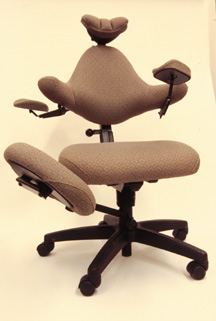Even fancy ergonomic chairs might not protect computer users from wrist injuries, Cornell study finds
By Susan Lang

No matter how fancy an ergonomic office chair is, it's probably not going to help prevent carpal tunnel syndrome or other wrist injuries that result from working at a computer keyboard, according to a new Cornell University study.
"This study debunks the commonly held view that a good ergonomic chair alone will reduce the risks of carpal tunnel syndrome. We see no evidence for that," says Alan Hedge, professor of design and environmental analysis at Cornell and director of Cornell's Human Factors and Ergonomics Laboratory. "We tested typists of all sizes in high-end ergonomic chairs that were adjusted for each participant according to manufacturer recommendations. Typists worked on a keyboard on a high-end, flat, adjustable keyboard tray that was also adjusted to them. None of the chairs made any difference in protecting the wrist angles of the typists."
Hedge's graduate student, Marisol Barrero, conducted the study for her master's thesis. She was assisted by Hedge and Timothy Muss, also one of Hedge's graduate students.
According to the manufacturers, all of the chairs' arms were designed for use during keyboarding. But an evaluation by the Cornell ergonomists found that typists in all of the chairs extended their wrists well beyond a neutral position, about twice the recommended extension angle to avoid injury.
The study, presented at the Human Factors and Ergonomics Society conference in Houston, Texas, last October, was published in the proceedings for the society's 43rd annual meeting (Vol. 1, pp. 584-588).
Barrero, with assistance from Muss, selected 24 healthy college students of varied stature who were competent typists. The researchers analyzed the students' wrist angles using electrogoniometers (computerized three- dimensional "measuring tapes"). With a video-motion system, they analyzed arm angles and upper- body posture while the students were typing in four different chairs with armrests. The chairs, which list for between $900 and $1,200 each, were among the best available on the market in terms of price, features and manufacturer's reputation.
"The chairs were selected to represent four different, state-of-the-art combinations of arm adjustment features," says Hedge. Even though all of the chairs had instructions suggesting certain positions for keyboarding, none of the chairs tested proved to be effective in reducing the postural risk of wrist injury, based on Hedge's safety criteria.
"The inference is that the arms on these high-end ergonomic chairs will improve typing position, but according to our study there are no statistically significant differences among the chairs. No matter what the design of its arms were, no chair significantly reduced the risk of wrist injury from typing.
"The study highlights the need to consider the ergonomic design of a chair in the context of the other workstation furniture to achieve an optimal work posture for computer use," says Hedge.
Related World Wide Web sites: The following sites provide additional information on this news release. Some might not be part of the Cornell University community, and Cornell has no control over their content or availability.
Media Contact
Get Cornell news delivered right to your inbox.
Subscribe